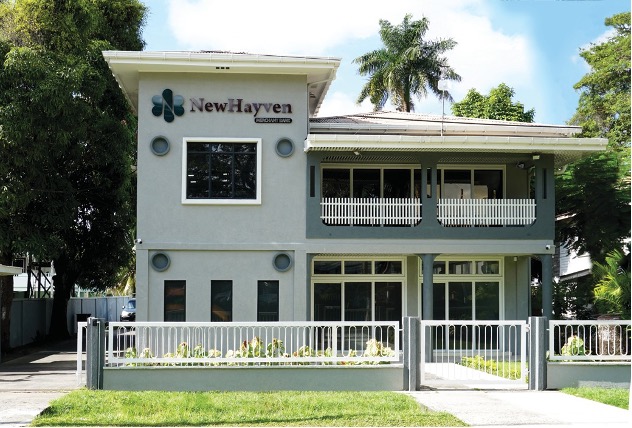
Share on Social Media
By Floyd Haynes, Chairman NewHayven Merchant Bank
The Discovery of Oil in Guyana’s Atlantic Basin in 2015 has ushered in a new era of unparalleled
business opportunities. One of the salient features of this new business environment is the ever increasing demand for project and other related forms of financing including equipment financing, factoring and accounts receivable financing.
Project Financing

Project financing is a specialized form of financing for large scale, long-term projects with a specific focus on infrastructure, energy, construction, and other capital- intensive ventures. Financing is structured based on the projected cash flows and assets of the project itself, rather than relying solely on the creditworthiness of the borrower.
In project financing, lenders assess the feasibility and profitabilityoftheproject, consideringfactorssuchasmarket demand, technical viability, regulatory compliance, and environmental impact. The financing is typically structured as non-recourse or limited recourse, which means that the lenders’ right to collect the pledged collateral is limited to specific project assets or revenue streams. This helps to mitigate risks for the lenders and allows them to evaluate the project’s viability independently.
Project financing often involves multiple parties, including lenders, project sponsors, contractors, equity investors, and sometimes government entities. The project sponsors are responsible for managing and executing the project, while lenders provide the necessary capital to finance its development. Lenders and other stakeholders assess the risks associated with the project and negotiate terms, such as interest rates, repayment schedules, and security arrangements.
The repayment of project financing is primarily based on the cash flow generated by the project itself, such as revenue from operations, tolls, user fees, or government payments. The lenders rely on the project’s ability to generate sufficient cash flow to repay the debt and provide a return on investment. The assets and revenue streams of the project are often used as collateral to secure the financing.
Equipment Financing
Equipment financing offers various methods of financing equipment purchases for business purposes. Some common types of equipment financing include:
 Equipment Loans - A business borrows funds from a lender to purchase equipment. The equipment serves as collateral for the loan, and the borrower repays the loan over a specified term, usually with interest. Equipment loans can be obtained from banks, credit unions, or alternative lenders.
Equipment Loans - A business borrows funds from a lender to purchase equipment. The equipment serves as collateral for the loan, and the borrower repays the loan over a specified term, usually with interest. Equipment loans can be obtained from banks, credit unions, or alternative lenders.
Equipment Leasing - An agreement, in which the lessor (financing company) purchases the equipment and leases it to the lessee (business) in exchange for regular payments. Leasing options include operating leases, where the lessor retains ownership and the lessee returns the equipment at the end of the lease term, or capital leases, which offer a purchase option for the lessee to acquire ownership.
Sale and leaseback - A financing arrangement where a business sells its existing equipment to a lessor and immediately leases it back. The business receives funds from the sale, while retaining the use of the equipment through a lease agreement. This option allows businesses to unlock capital tied up in equipment they already own.
Equipment Financing Agreements (EFA) – EFA’s are similar to equipment loans but typically involve longer repayment terms with potentially different tax and accounting implications. In an EFA, the business borrows funds from a lender to purchase equipment, and the lender takes a security interest in the equipment. Once the loan is fully paid, the ownership of the equipment transfers to the borrower.
Equipment Sale Financing - In-house financing offered by some equipment vendors to customers purchasing their equipment. These financing programs streamline the equipment purchase process by providing financing directly from the vendor. The business makes regular payments to the vendor over a specified term.
Equipment Line of Credit - A revolving credit facility specifically designed for acquiring equipment. The lender establishes a predetermined credit limit, and the business candrawfundsfromthelineofcredittopurchaseequipment as needed. As the business repays the borrowed amount, the credit becomes available again for future equipment purchases.
It’s important for businesses to consider their specific equipment needs, financial situation, and repayment preferences when choosing the most suitable equipment financing option.
Factoring and Accounts Receivable Financing
Factoring and accounts receivable financing are two related methods of financing that involve using a company’s accounts receivable as collateral.
In factoring a company sells its accounts receivable (unpaid invoices) to a third-party financial institution known as a factor at a discounted rate, of around 70-90% of their total value. This provides immediate cash to the company. The factor then takes responsibility for collecting payment from the customers who owe the invoices. Once the customers pay, the factor deducts its fees and returns the remaining balance (reserve) to the company. Factoring allows businesses to improve cash flow by converting their receivables into immediate working capital.
Accounts receivable financing, also known as invoice financing or receivables-based lending, is a broader term that encompasses various financing arrangements secured by a company’s accounts receivable. In this method, a company borrows money from a lender by pledging its outstanding invoices as collateral. The lender evaluates the creditworthiness of the company’s customers and advances a percentage of the accounts receivable’s value, usually around 70-90%. The company then repays the loan, along with interest and fees, as its customers settle their invoices. Accounts receivable financing provides businesses with quick access to capital while still retaining control of the collection process.
Both factoring and accounts receivable financing offer benefits to businesses, including improved cash flow, reduced reliance on customer payments, and flexibility in managing working capital.
Financing is a valuable tool for managing cash flow and accessing working capital for growing companies. Consulting with financial advisors or lenders can help a business to carefully evaluate their specific needs, consider the costs and benefits, and choose the financing option that aligns best with their goals and circumstances.
Floyd Haynes is the founder and Chairman of NewHayven Merchant Bank in Georgetown Guyana. He founded Haynes, Inc., a multi-million-dollar accounting services firm in the United
States serving public and private sector clients. Haynes served on the local content advisory panel, and is currently the Project Lead on the Cost Recovery audit of EEPGL claimed costs. Mr. Haynes is a graduate of Harvard University Kennedy School of Government, and the University of Oxford Saïd Business School. He is a Certified Public Accountant, and Certified Fraud Examiner.
